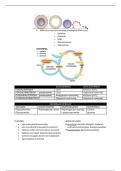College aantekeningen
College aantekeningen Neuropsychologie RU 2023/2024
- Instelling
- Radboud Universiteit Nijmegen (RU)
Ik heb met deze aantekeningen alleen al een 9,8 behaald! Geen reden dus om dure boeken aan te schaffen. Dit document bevat zeer uitgebreide college aantekeningen van alle stof die je nodig hebt voor het vak Neuropsychology, een vak gegeven in het tweede jaar van Pedagogische Wetenschappen aan de Ra...
[Meer zien]











